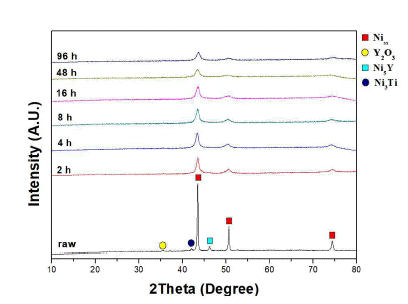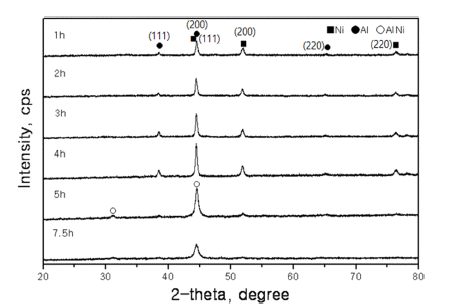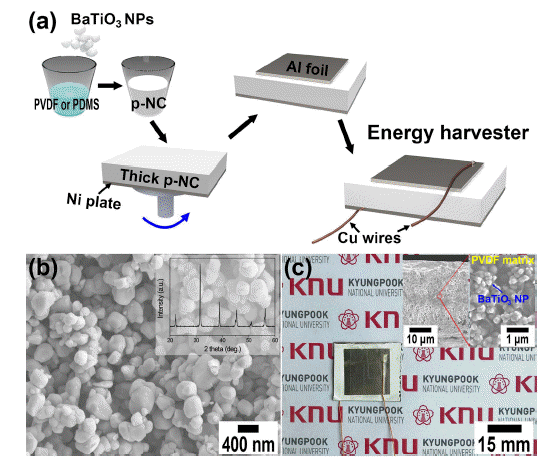Previous issues
- Page Path
- HOME > Browse Articles > Previous issues
- [Korean]
- Analysis on Milling Behavior of Oxide Dispersion Strengthened Ni-based Atomizing Powder with Ni5Y Intermetallic Phase
- Chun Woong Park, Jong Min Byun, Won June Choi, Young Do Kim
- J Korean Powder Metall Inst. 2019;26(2):101-106. Published online April 1, 2019
- DOI: https://doi.org/10.4150/KPMI.2019.26.2.101

- 823 View
- 3 Download
- 2 Citations
-
 Abstract
Abstract
 PDF
PDF Ni-based oxide dispersion strengthened (ODS) alloys have a higher usable temperature and better hightemperature mechanical properties than conventional superalloys. They are therefore being explored for applications in various fields such as those of aerospace and gas turbines. In general, ODS alloys are manufactured from alloy powders by mechanical alloying of element powders. However, our research team produces alloy powders in which the Ni5Y intermetallic phase is formed by an atomizing process. In this study, mechanical alloying was performed using a planetary mill to analyze the milling behavior of Ni-based oxide dispersions strengthened alloy powder in which the Ni5Y is the intermetallic phase. As the milling time increased, the Ni5Y intermetallic phase was refined. These results are confirmed by SEM and EPMA analysis on microstructure. In addition, it is confirmed that as the milling increased, the mechanical properties of Ni-based ODS alloy powder improve due to grain refinement by plastic deformation.
-
Citations
Citations to this article as recorded by- Efficient prediction of corrosion behavior in ternary Ni-based alloy systems: Theoretical calculations and experimental verification
Xuelian Xiao, Keke Chang, Kai Xu, Ming Lou, Liping Wang, Qunji Xue
Journal of Materials Science & Technology.2023; 167: 94. CrossRef - Effect of high-energy ball milling on the microstructure and mechanical properties of Ni-based ODS alloys fabricated using gas-atomized powder
Chun Woong Park, Won June Choi, Jongmin Byun, Young Do Kim
Journal of Materials Science.2022; 57(38): 18195. CrossRef
- Efficient prediction of corrosion behavior in ternary Ni-based alloy systems: Theoretical calculations and experimental verification
- [Korean]
- Prediction the Phase Transformation Time of Binary Alloy System by calculating the Input Energy of Mechanical Alloying
- Dong-Kyu Park, In-Shup Ahn
- J Korean Powder Metall Inst. 2019;26(2):107-111. Published online April 1, 2019
- DOI: https://doi.org/10.4150/KPMI.2019.26.2.107

- 482 View
- 1 Download
-
 Abstract
Abstract
 PDF
PDF The activation energy to create a phase transformation or for the reaction to move to the next stage in the milling process can be calculated from the slop of the DSC plot, obtained at the various heating rates for mechanically activated Al-Ni alloy systems by using Kissinger’s equation. The mechanically activated material has been called “the driven material” as it creates new phases or intermetallic compounds of AlNi in Al-Ni alloy systems. The reaction time for phase transformation by milling can be calculated using the activation energy obtained from the above mentioned method and from the real required energy. The real required energy (activation energy) could be calculated by subtracting the loss energy from the total input energy (calculated input energy from electric motor). The loss energy and real required energy divided by the reaction time are considered the “metabolic energy” and “the effective input energy”, respectively. The milling time for phase transformation at other Al-Co alloy systems from the calculated data of Al-Ni systems can be predicted accordingly.
- [Korean]
- Thermal Properties and Microstructural Changes of Fe-Co System Valve Seat Alloy by High Densification Process
- In-Shup Ahn, Dong-Kyu Park, Kwang-Bok Ahn, Seoung-Mok Shin
- J Korean Powder Metall Inst. 2019;26(2):112-118. Published online April 1, 2019
- DOI: https://doi.org/10.4150/KPMI.2019.26.2.112

- 736 View
- 6 Download
-
 Abstract
Abstract
 PDF
PDF Infiltration is a popular technique used to produce valve seat rings and guides to create dense parts. In order to develop valve seat material with a good thermal conductivity and thermal expansion coefficient, Cu-infiltrated properties of sintered Fe-Co-M(M=Mo,Cr) alloy systems are studied. It is shown that the copper network that forms inside the steel alloy skeleton during infiltration enhances the thermal conductivity and thermal expansion coefficient of the steel alloy composite. The hard phase of the CoMoCr and the network precipitated FeCrC phase are distributed homogeneously as the infiltrated Cu phase increases. The increase in hardness of the alloy composite due to the increase of the Co, Ni, Cr, and Cu contents in Fe matrix by the infiltrated Cu amount increases. Using infiltration, the thermal conductivity and thermal expansion coefficient were increased to 29.5 W/mK and 15.9 um/m°C, respectively, for tempered alloy composite.
- [Korean]
- A Comparison Study of Output Performance of Organic-Inorganic Piezoelectric Nanocomposite Made of Piezoelectric/Non-piezoelectric Polymers and BaTiO3 Nanoparticles
- Dong Yeol Hyeon, Kwi-Il Park
- J Korean Powder Metall Inst. 2019;26(2):119-125. Published online April 1, 2019
- DOI: https://doi.org/10.4150/KPMI.2019.26.2.119

- 723 View
- 3 Download
- 5 Citations
-
 Abstract
Abstract
 PDF
PDF Piezoelectric energy harvesting technology is attracting attention, as it can be used to convert more accessible mechanical energy resources to periodic electricity. Recent developments in the field of piezoelectric energy harvesters (PEHs) are associated with nanocomposites made from inorganic piezoelectric nanomaterials and organic elastomers. Here, we used the BaTiO3 nanoparticles and piezoelectric poly(vinylidene fluoride) (PVDF) polymeric matrix to fabricate the nanocomposites-based PEH to improve the output performance of PEHs. The piezoelectric nanocomposite is produced by dispersing the inorganic piezo-ceramic nanoparticles inside an organic piezo-polymer and subsequently spin-coat it onto a metal plate. The fabricated organic-inorganic piezoelectric nanocomposite-based PEH harvested the output voltage of ~1.5 V and current signals of ~90 nA under repeated mechanical pushings: these values are compared to those of energy devices made from non-piezoelectric polydimethylsiloxane (PDMS) elastomers and supported by a multiphysics simulation software.
-
Citations
Citations to this article as recorded by- Development and Characterization of Hafnium-Doped BaTiO3 Nanoparticle-Based Flexible Piezoelectric Devices
HakSu Jang, Hyeon Jun Park, Gwang Hyeon Kim, Gyoung-Ja Lee, Jae-Hoon Ji, Donghun Lee, Young Hwa Jung, Min-Ku Lee, Changyeon Baek, Kwi-Il Park
JOURNAL OF SENSOR SCIENCE AND TECHNOLOGY.2024; 33(1): 34. CrossRef - Enhanced energy harvesting of fibrous composite membranes via plasma-piezopolymer interaction
Hyeon Jun Park, Bitna Bae, HakSu Jang, Dong Yeol Hyeon, Dong Hun Lee, Gwang Hyun Kim, Cheol Min Kim, Nagamalleswara Rao Alluri, Changyeon Baek, Min-Ku Lee, Gyoung-Ja Lee, Kwi-Il Park
Nano Energy.2024; 131: 110299. CrossRef - Effects of Mixing Ratio and Poling on Output Characteristics of BaTiO3-Poly Vinylidene Fluoride Composite Piezoelectric Generators
Hee-Tae Kim, Sang-Shik Park
Korean Journal of Materials Research.2023; 33(12): 517. CrossRef - Stretchable Sensor Array Based on Lead-Free Piezoelectric Composites Made of BaTiO3 Nanoparticles and Polymeric Matrix
Jun Ho Bae, Seong Su Ham, Sung Cheol Park, Kwi-Il Park
JOURNAL OF SENSOR SCIENCE AND TECHNOLOGY.2022; 31(5): 312. CrossRef - Flexible Energy Harvester Made of Organic-Inorganic Hybrid Piezoelectric Nanocomposite
Yu Jeong Kwon, Dong Yeol Hyeon, Kwi-Il Park
Korean Journal of Materials Research.2019; 29(6): 371. CrossRef
- Development and Characterization of Hafnium-Doped BaTiO3 Nanoparticle-Based Flexible Piezoelectric Devices
- [Korean]
- Lattice Deformation and Improvement Oxidation Resistance of Ti-6Al-4V Alloy Powders Prepared by Hydrogen Added Argon Heat Treatment
- Gye-Hoon Cho, Jung-Min Oh, Jae-Won Lim
- J Korean Powder Metall Inst. 2019;26(2):126-131. Published online April 1, 2019
- DOI: https://doi.org/10.4150/KPMI.2019.26.2.126

- 435 View
- 1 Download
-
 Abstract
Abstract
 PDF
PDF In the present work, a new hydrogen added argon heat treatment process that prevents the formation of hydrides and eliminates the dehydrogenation step, is developed. Dissolved hydrogen has a good effect on sintering properties such as oxidation resistance and density of greens. This process can also reduce costs and processing time. In the experiment, commercially available Ti-6Al-4V powders are used. The powders are annealed using tube furnace in an argon atmosphere at 700°C and 900°C for 120 min. Hydrogen was injected temporarily during argon annealing to dissolve hydrogen, and a dehydrogenation process was performed simultaneously under an argon-only atmosphere. Without hydride formation, hydrogen was dissolved in the Ti-6Al-4V powder by X-ray diffraction and gas analysis. Hydrogen is first solubilized on the beta phase and expanded the beta phases’ cell volume. TGA analysis was carried out to evaluate the oxidation resistance, and it is confirmed that hydrogen-dissolved Ti-6Al-4V powders improves oxidation resistance more than raw materials.
- [Korean]
- Property Evaluation of Tungsten-Carbide Hard Materials as a Function of Binder
- Ju-Hun Kim, Ik-Hyun Oh, Jeong-Han Lee, Sung-Kil Hong, Hyun-Kuk Park
- J Korean Powder Metall Inst. 2019;26(2):132-137. Published online April 1, 2019
- DOI: https://doi.org/10.4150/KPMI.2019.26.2.132

- 834 View
- 8 Download
- 3 Citations
-
 Abstract
Abstract
 PDF
PDF Tungsten carbide (WC) hard materials are used in various industries and possess a superior hardness compared to other hard materials. They have particularly high melting points, high strength, and abrasion resistance. Accordingly, tungsten carbide hard materials are used for wear-resistant tools, cutting tools, machining tools, and other tooling materials. In this study, the WC-5wt.%Co, Fe, Ni hard materials are densified using the horizontal ball milled WC-Co, WC-Fe, and WC-Ni powders by a spark plasma sintering process. The WC-5Co, WC-5Fe, and WC-5Ni hard materials are almost completely densified with a relative density of up to 99.6% after simultaneous application of a pressure of 60 MPa and an electric current for about 15 min without any significant change in the grain size. The average grain size of WC-5Co, WC-5Fe, and WC-5Ni that was produced through SPS was about 0.421, 0.779, and 0.429 μm, respectively. The hardness and fracture toughness of the dense WC-5Co, WC-5Fe, WC-5Ni hard materials were also investigated.
-
Citations
Citations to this article as recorded by- Enhancing Mechanical Properties via Grain Growth Suppression and High Densification in WC Compacts
Jong Min Gwak, Min Soo Park, Gook Hyun Ha, Nam Hyun Kang
Metals and Materials International.2025;[Epub] CrossRef - Synthesis of W2C by Spark Plasma Sintering of W-WC Powder Mixture and Its Etching Property
Gyu-Sang Oh, Sung-Min Lee, Sung-Soo Ryu
Journal of Korean Powder Metallurgy Institute.2020; 27(4): 293. CrossRef - Fabrication and Properties of Densified Tungsten by Magnetic Pulse Compaction and Spark Plasma Sintering
Eui Seon Lee, Jongmin Byun, Young-Keun Jeong, Sung-Tag Oh
Korean Journal of Materials Research.2020; 30(6): 321. CrossRef
- Enhancing Mechanical Properties via Grain Growth Suppression and High Densification in WC Compacts
- [Korean]
- Microstructures and Characterization of Al-Si-Mg Alloy Processed by Selective Laser Melting with Post-Heat-treatment
- Gi Seung Lee, Yeong Seong Eom, Kyung Tae Kim, Byoung Kee Kim, Ji Hun Yu
- J Korean Powder Metall Inst. 2019;26(2):138-145. Published online April 1, 2019
- DOI: https://doi.org/10.4150/KPMI.2019.26.2.138

- 1,257 View
- 11 Download
- 3 Citations
-
 Abstract
Abstract
 PDF
PDF In this study, Al-Si-Mg alloys are additively manufactured using a selective laser melting (SLM) process from AlSi10Mg powders prepared from a gas-atomization process. The processing parameters such as laser scan speed and laser power are investigated for 3D printing of Al-Si-Mg alloys. The laser scan speeds vary from 100 to 2000 mm/s at the laser power of 180 and 270W, respectively, to achieve optimized densification of the Al-Si-Mg alloy. It is observed that the relative density of the Al-Si-Mg alloy reaches a peak value of 99% at 1600 mm/s for 180W and at 2000 mm/s for 270W. The surface morphologies of the both Al-Si-Mg alloy samples at these conditions show significantly reduced porosities compared to those of other samples. The increase in hardness of as-built Al-Si-Mg alloy with increasing scan speed and laser power is analyzed due to high relative density. Furthermore, it was found that cooling conditions after the heat-treatment for homogenization results in the change of dispersion status of Si phases in the Al-Si matrix but also affects tensile behaviors of Al-Si-Mg alloys. These results indicate that combination between SLM processing parameters and post-heat treatment should be considered a key factor to achieve optimized Al-Si alloy performance.
-
Citations
Citations to this article as recorded by- Fabrication and mechanical properties of Al–Si-based alloys by selective laser melting process
Yeong Seong Eom, Kyung Tae Kim, Dong Won Kim, Soo ho Jung, Jung Woo Nam, Dong Yeol Yang, Jungho Choe, Ji Hun Yu, Injoon Son
Powder Metallurgy.2021; 64(3): 198. CrossRef - Investigation on Interfacial Microstructures of Stainless Steel/Inconel Bonded by Directed Energy Deposition of alloy Powders
Yeong Seong Eom, Kyung Tae Kim, Soo-Ho Jung, Jihun Yu, Dong Yeol Yang, Jungho Choe, Chul Yong Sim, Seung Jun An
Journal of Korean Powder Metallurgy Institute.2020; 27(3): 219. CrossRef - Influence of Powder Size on Properties of Selectively Laser-Melted- AlSi10Mg Alloys
Yeong Seong Eom, Dong Won Kim, Kyung Tae Kim, Sang Sun Yang, Jungho Choe, Injoon Son, Ji Hun Yu
Journal of Korean Powder Metallurgy Institute.2020; 27(2): 103. CrossRef
- Fabrication and mechanical properties of Al–Si-based alloys by selective laser melting process
- [Korean]
- Research trend in Fabrication of Metastable-phase Iron Nitrides for Hard Magnetic Applications
- Kyung Min Kim, Jung-Goo Lee, Kyung Tae Kim, Youn-Kyoung Baek
- J Korean Powder Metall Inst. 2019;26(2):146-155. Published online April 1, 2019
- DOI: https://doi.org/10.4150/KPMI.2019.26.2.146

- 1,363 View
- 22 Download
- 1 Citations
-
 Abstract
Abstract
 PDF
PDF Rare earth magnets are the strongest type of permanent magnets and are integral to the high tech industry, particularly in clean energies, such as electric vehicle motors and wind turbine generators. However, the cost of rare earth materials and the imbalance in supply and demand still remain big problems to solve for permanent magnet related industries. Thus, a magnet with abundant elements and moderate magnetic performance is required to replace rare-earth magnets. Recently, a”-Fe16N2 has attracted considerable attention as a promising candidate for next-generation non-rare-earth permanent magnets due to its gigantic magnetization (3.23 T). Also, metastable a”-Fe16N2 exhibits high tetragonality (c/a = 1.1) by interstitial introduction of N atoms, leading to a high magnetocrystalline anisotropy constant (K1 = 1.0MJ/m3). In addition, Fe has a large amount of reserves on the Earth compared to other magnetic materials, leading to low cost of raw materials and manufacturing for industrial production. In this paper, we review the synthetic methods of metastable a”-Fe16N2 with film, powder and bulk form and discuss the approaches to enhance magnetocrystalline anisotropy of a”-Fe16N2. Future research prospects are also offered with patent trends observed thus far.
-
Citations
Citations to this article as recorded by- Failure Cases according to Photocuring-Based Alumina 3D Printing
So-Young Ko, Shin-Il Go, Kyoung-Jun Jang, Sang-Jin Lee
Korean Journal of Materials Research.2024; 34(10): 457. CrossRef
- Failure Cases according to Photocuring-Based Alumina 3D Printing
- [Korean]
- Research Trends of the Mo-Si-B Alloys as Next Generation Ultra-high-temperature Alloys
- Won June Choi, Chun Woong Park, Jung Hyo Park, Young Do Kim, Jong Min Byun
- J Korean Powder Metall Inst. 2019;26(2):156-165. Published online April 1, 2019
- DOI: https://doi.org/10.4150/KPMI.2019.26.2.156

- 1,224 View
- 22 Download
- 4 Citations
-
 Abstract
Abstract
 PDF
PDF Over the last decade, the next generation’s ultra-high-temperature materials as an alternative to Nickel-based superalloys have been highlighted. Ultra-high-temperature materials based on refractory metals are one of several potential candidates. In particular, molybdenum alloys with small amounts of silicon and boron (Mo-Si-B alloys) have superior properties at high temperature. However, research related to Mo-Si-B alloys were mainly conducted by several developed countries but garnered little interest in Korea. Therefore, in this review paper, we introduce the development history of Mo-Si-B alloys briefly and discuss the properties, particularly the mechanical and oxidation properties of Mo-Si-B alloys. We also introduce the latest research trends of Mo-Si-B alloys based on the research paper. Finally, for domestic research related to this field, we explain why Mo-Si-B alloys should be developed and suggest the potential directions for Mo-Si-B alloys research.
-
Citations
Citations to this article as recorded by- Thermal Stability and Weight Reduction of Al0.75V2.82CrZr Refractory High Entropy Alloy Prepared Via Mechanical Alloying
Minsu Kim, Hansung Lee, Byungmin Ahn
journal of Korean Powder Metallurgy Institute.2023; 30(6): 478. CrossRef - Preparation and Structure of Chromium Coatings Doped with Diamond Nanoparticles Deposited Directly on a Monolithic Composite of Molybdenum and Aluminum
V. P. Petkov, M. K. Aleksandrova, R. V. Valov, V. P. Korzhov, V. M. Kiiko, I. S. Zheltyakova
Protection of Metals and Physical Chemistry of Surfaces.2023; 59(3): 396. CrossRef - A Review of Mo-Si Intermetallic Compounds as Ultrahigh-Temperature Materials
Liang Jiang, Bin Zheng, Changsong Wu, Pengxiang Li, Tong Xue, Jiandong Wu, Fenglan Han, Yuhong Chen
Processes.2022; 10(9): 1772. CrossRef - Heat-Resistant Molybdenum Borosilicate Alloys Hardened with Titanium Carbides: Mo–Si–B–TiC (Survey)
I. L. Svetlov, O. G. Ospennikova, M. I. Karpov, Yu. V. Artemenko
Inorganic Materials: Applied Research.2021; 12(4): 866. CrossRef
- Thermal Stability and Weight Reduction of Al0.75V2.82CrZr Refractory High Entropy Alloy Prepared Via Mechanical Alloying
TOP
 KPMI
KPMI




 First
First Prev
Prev


